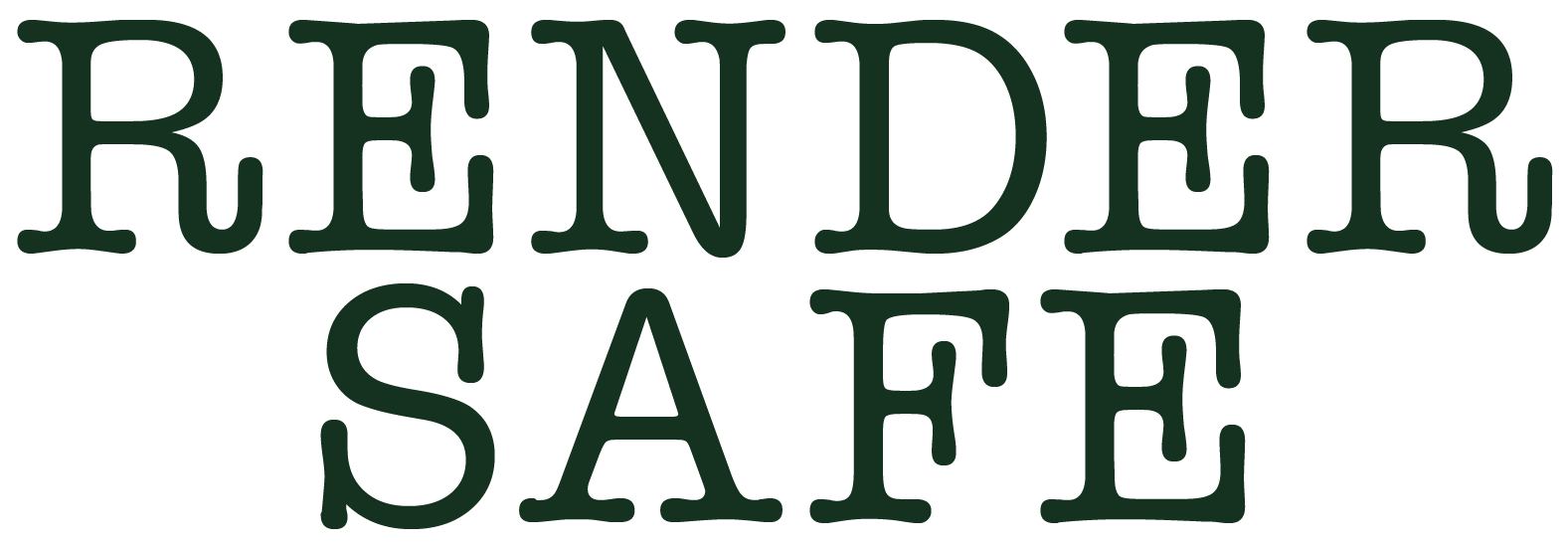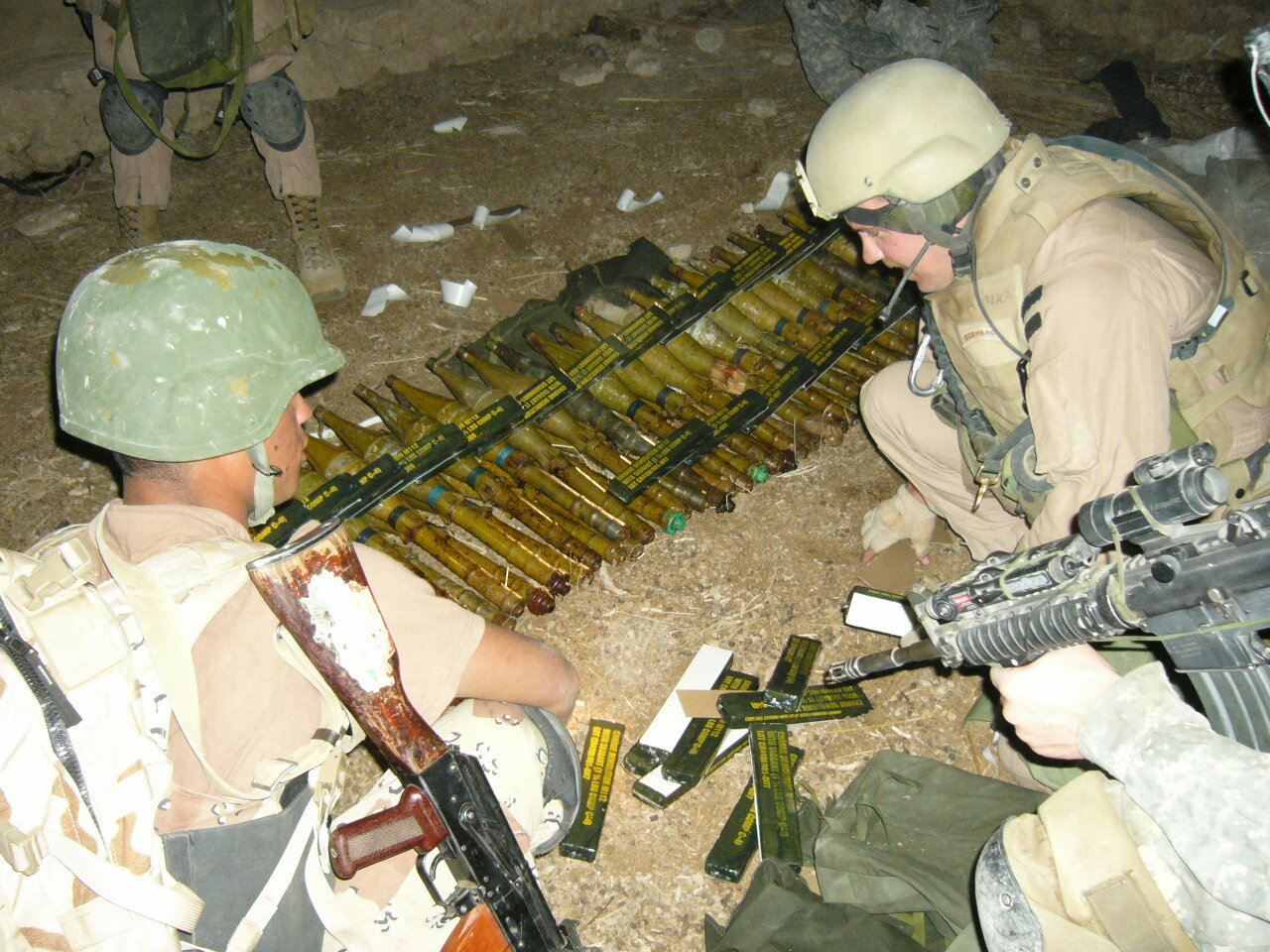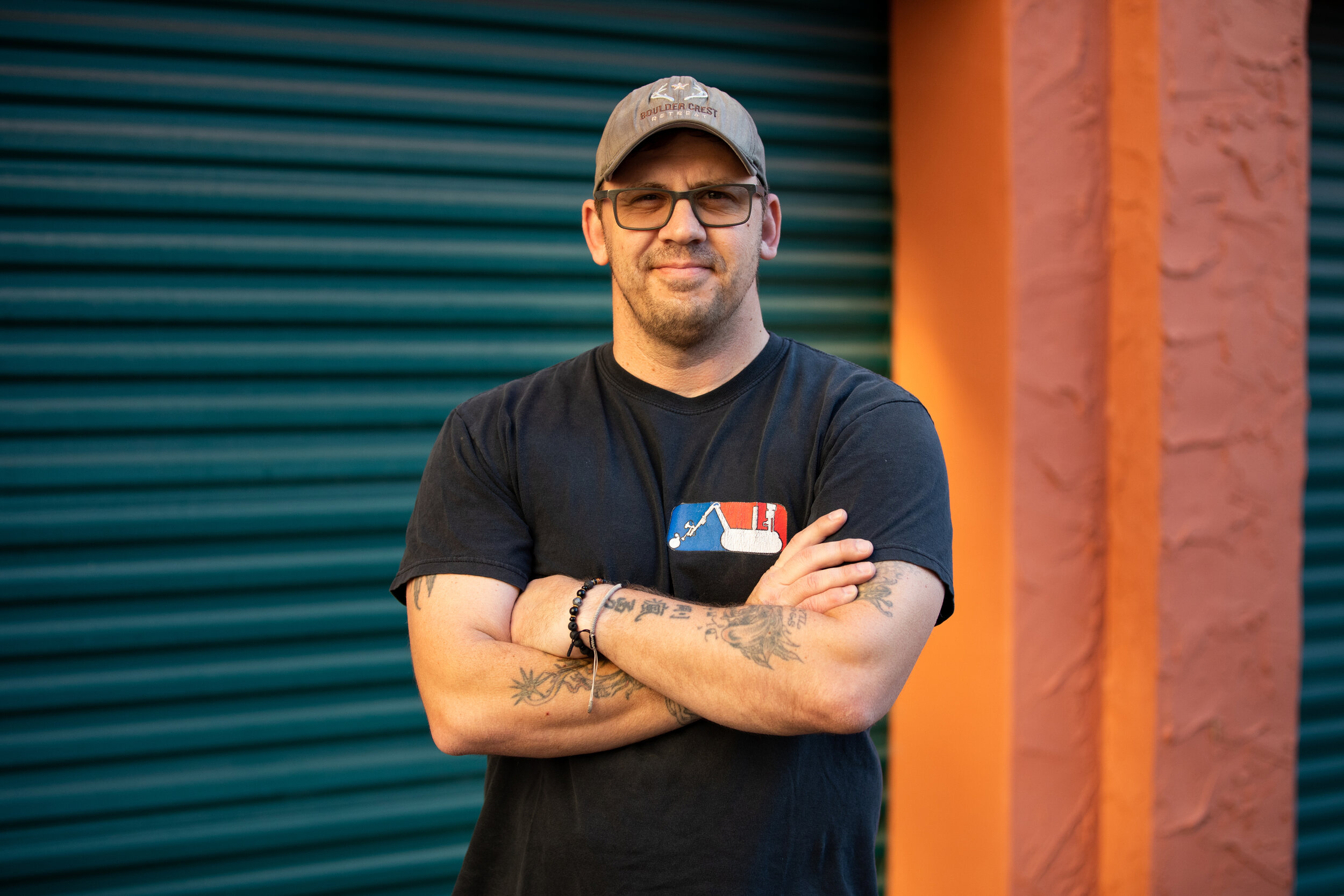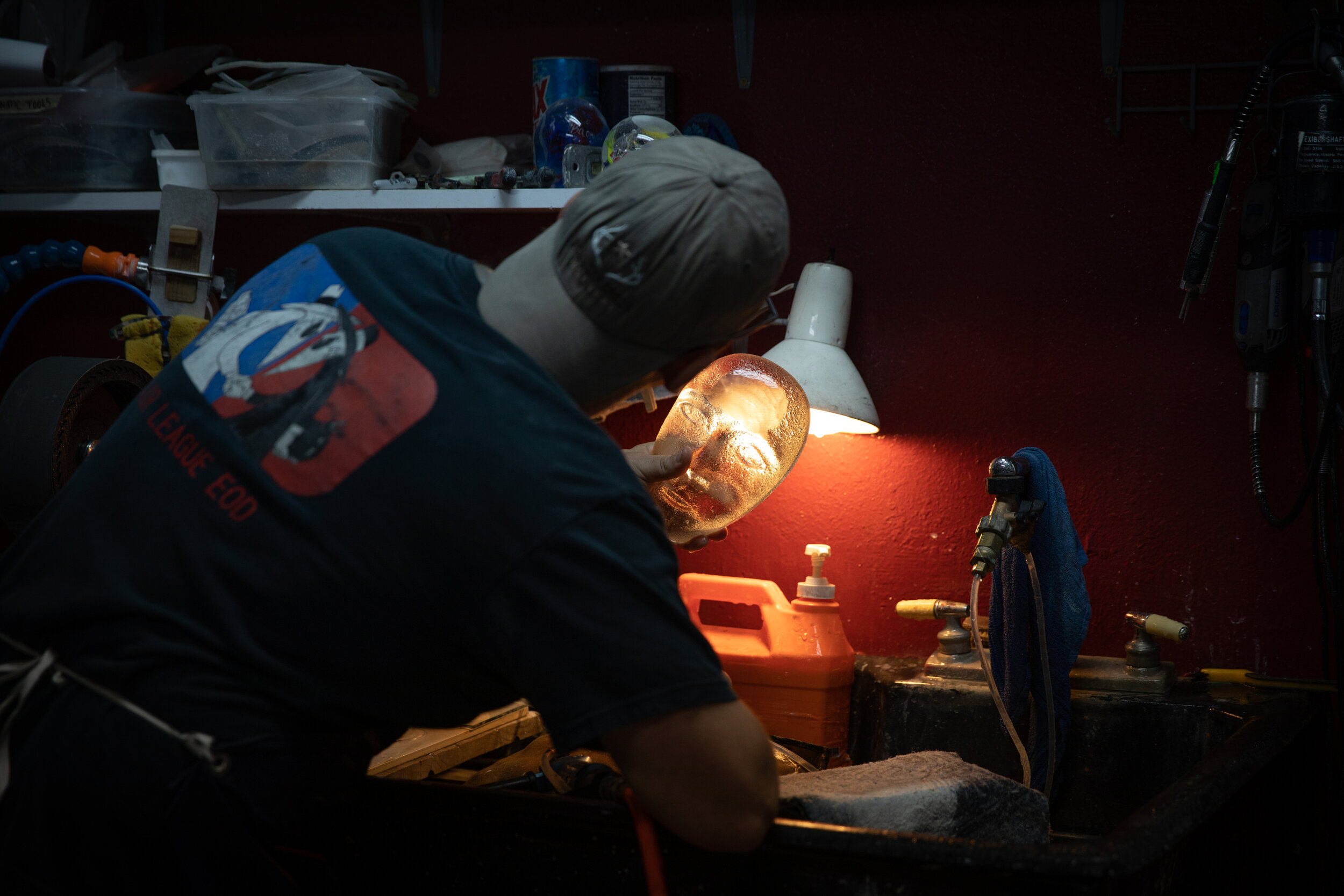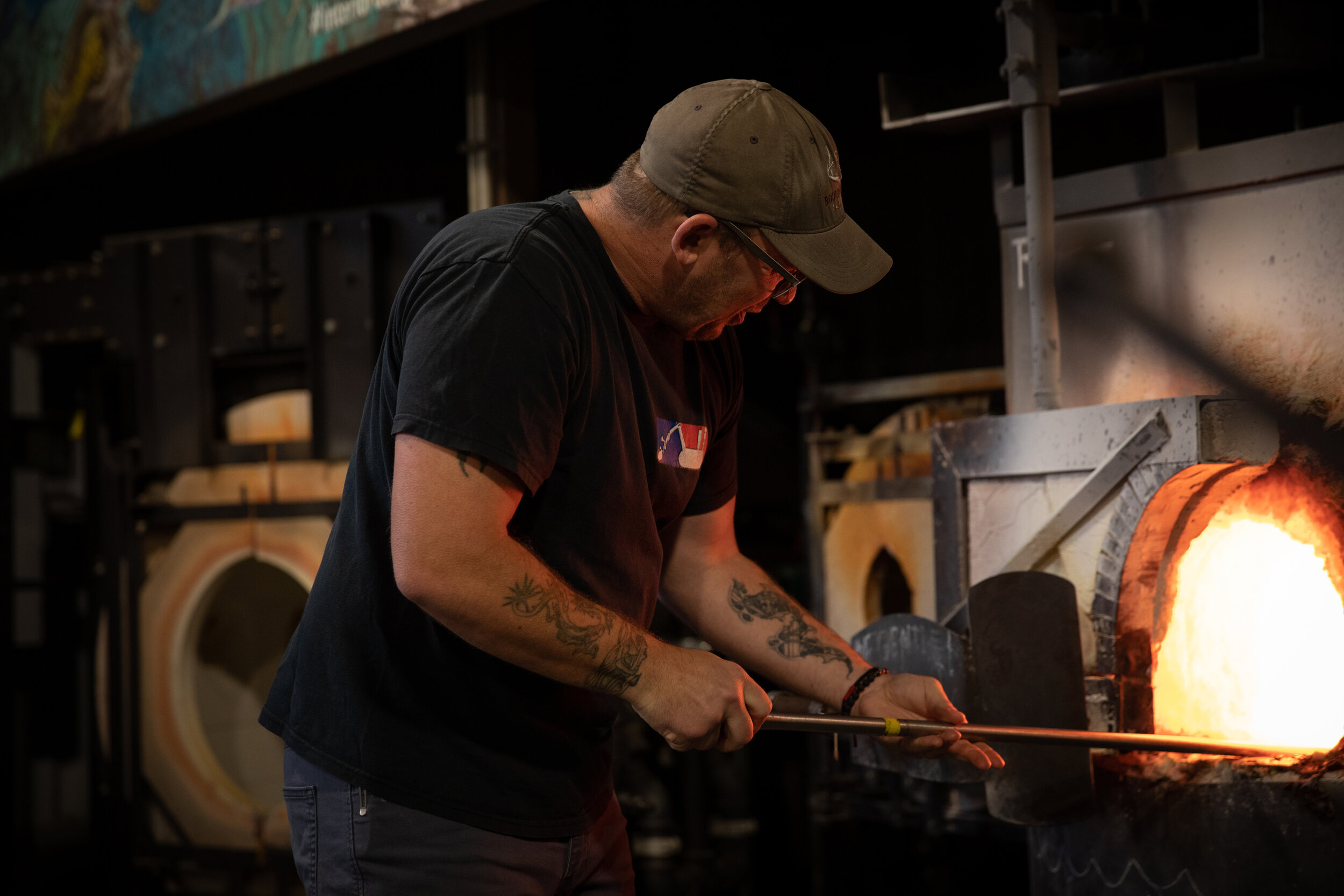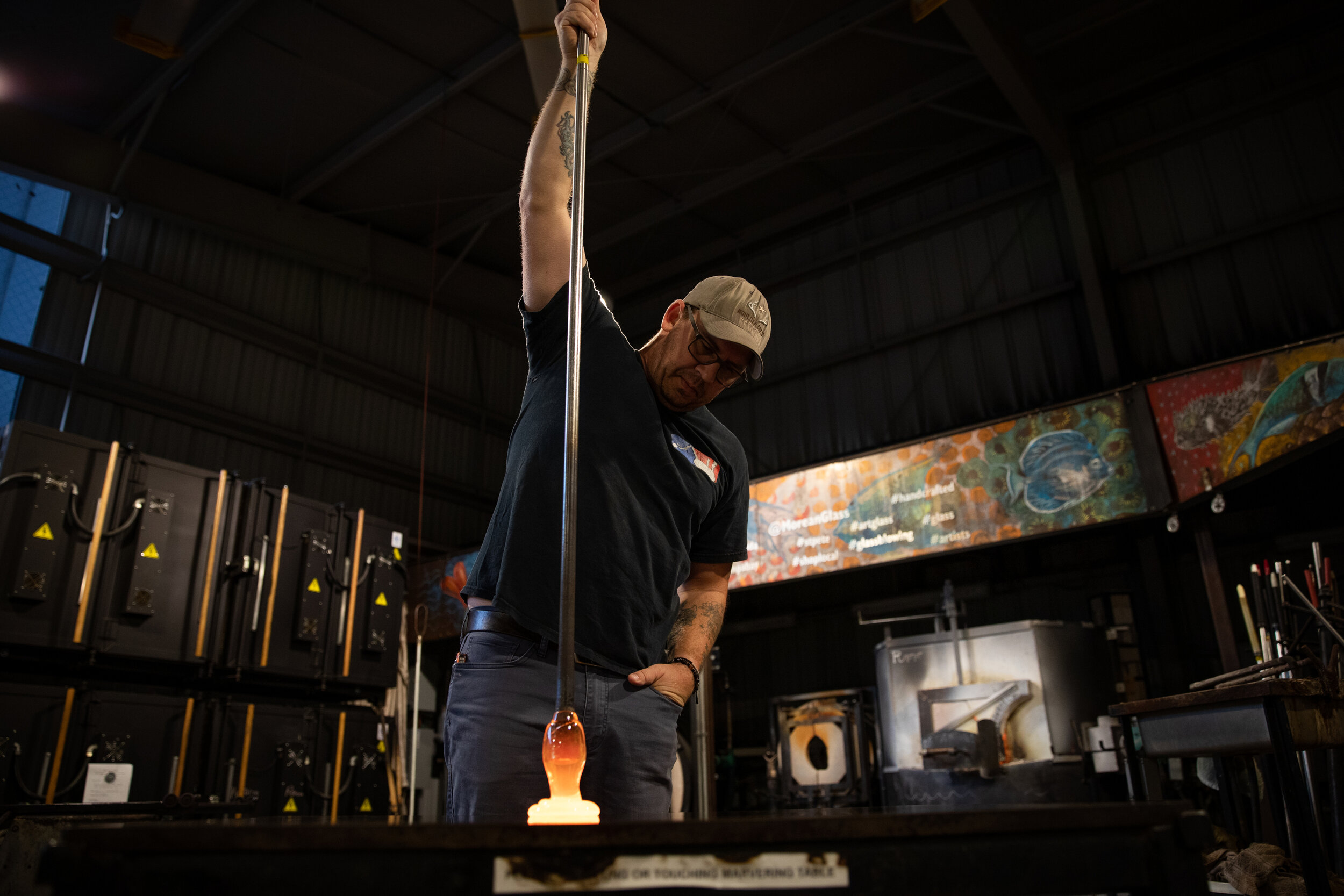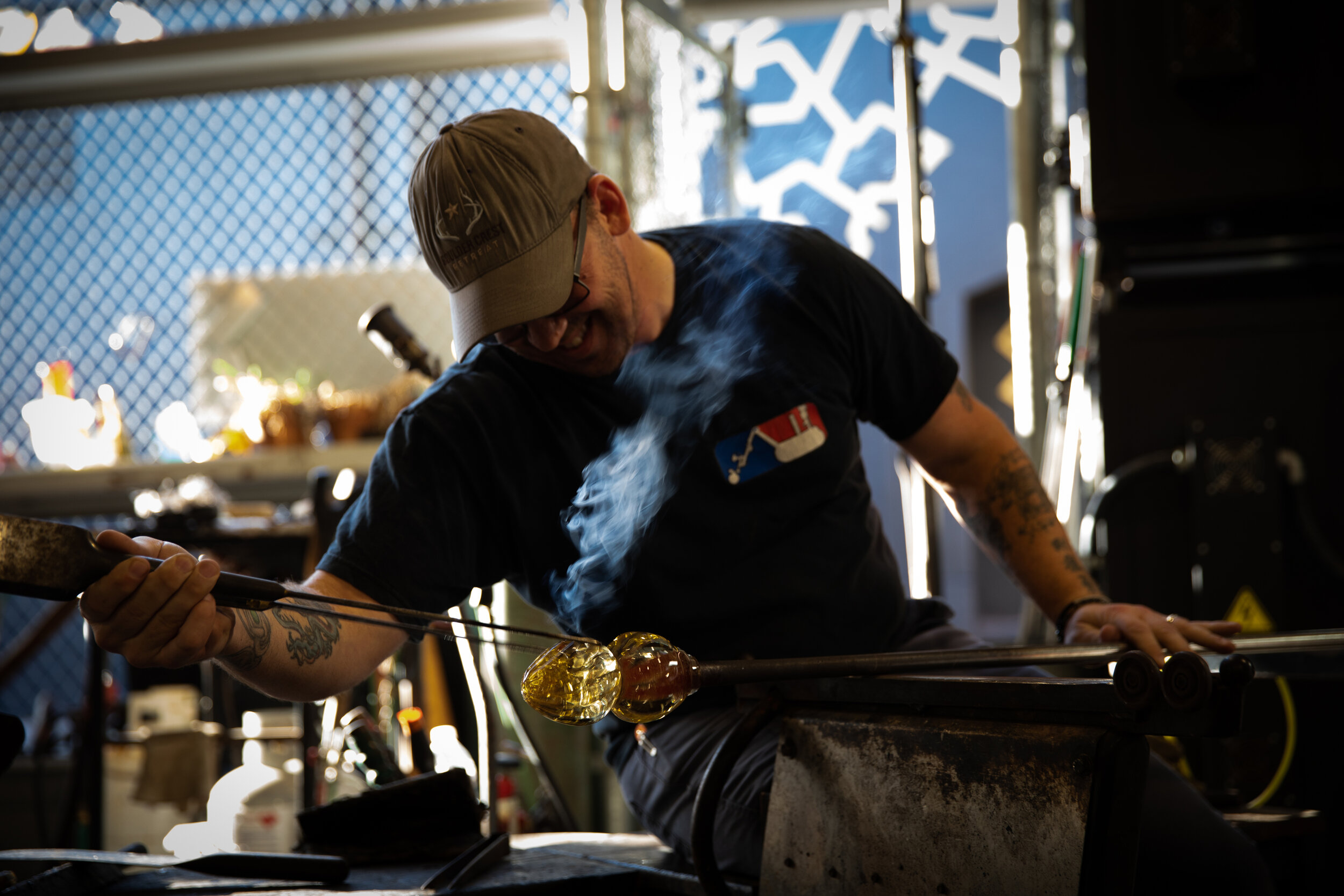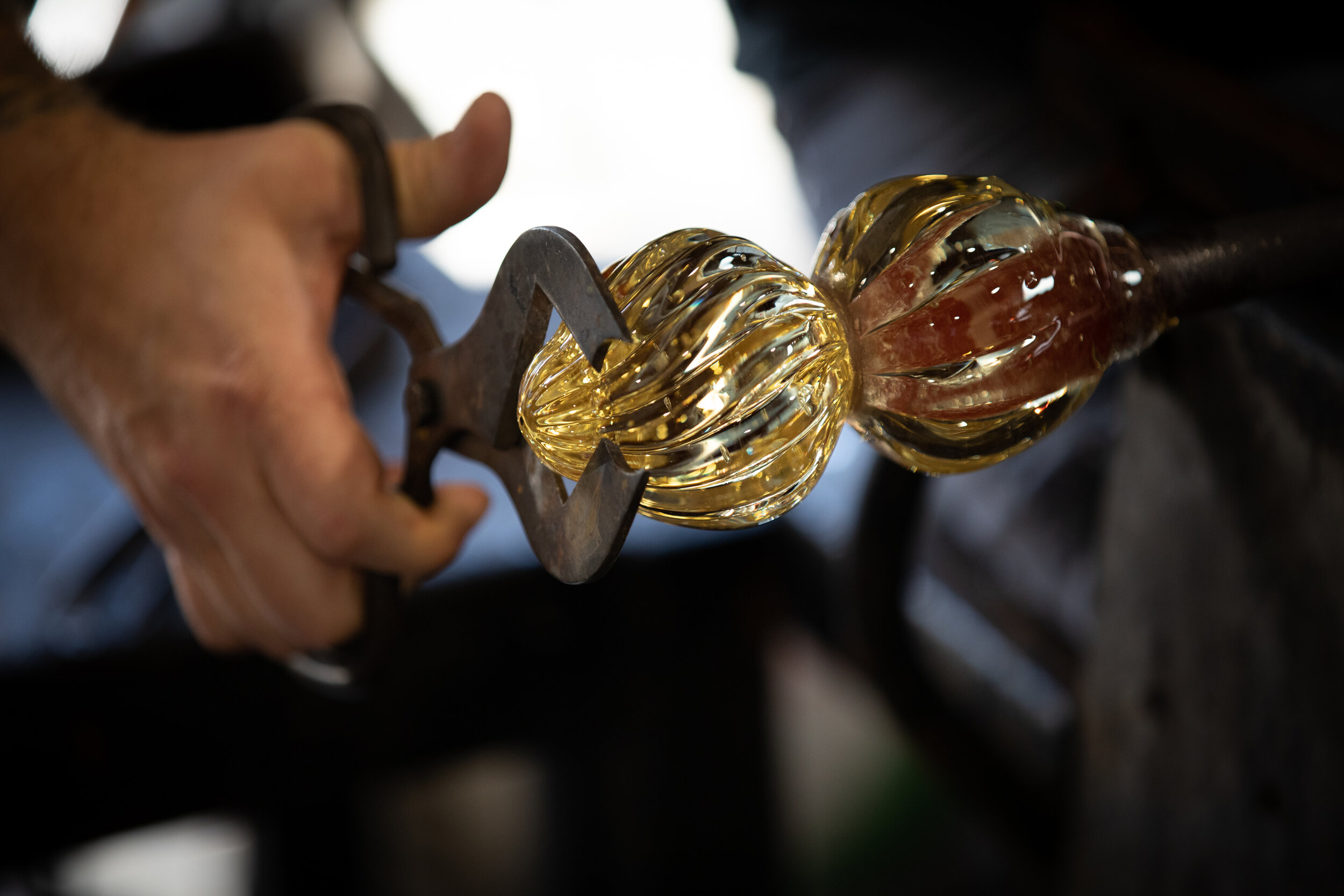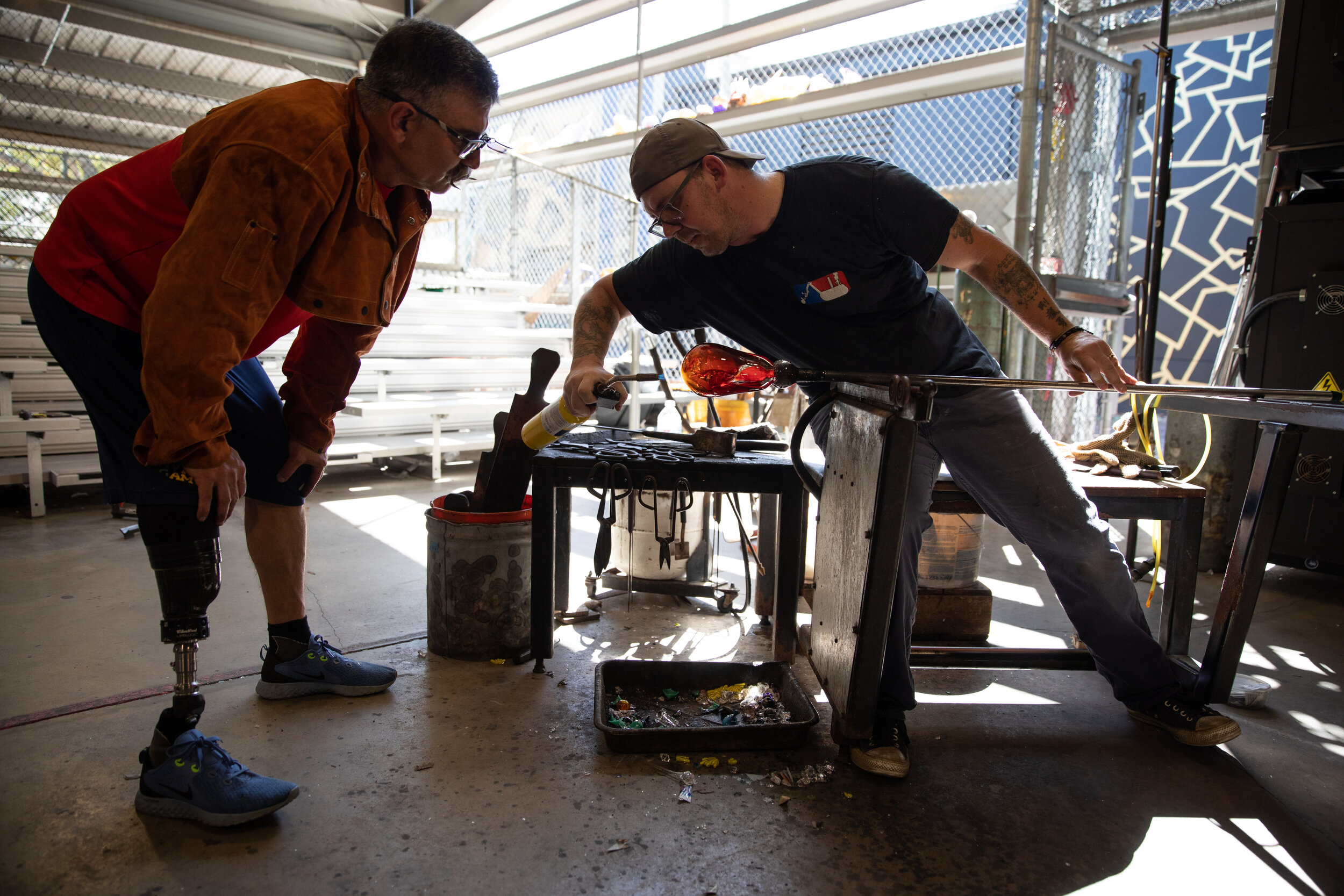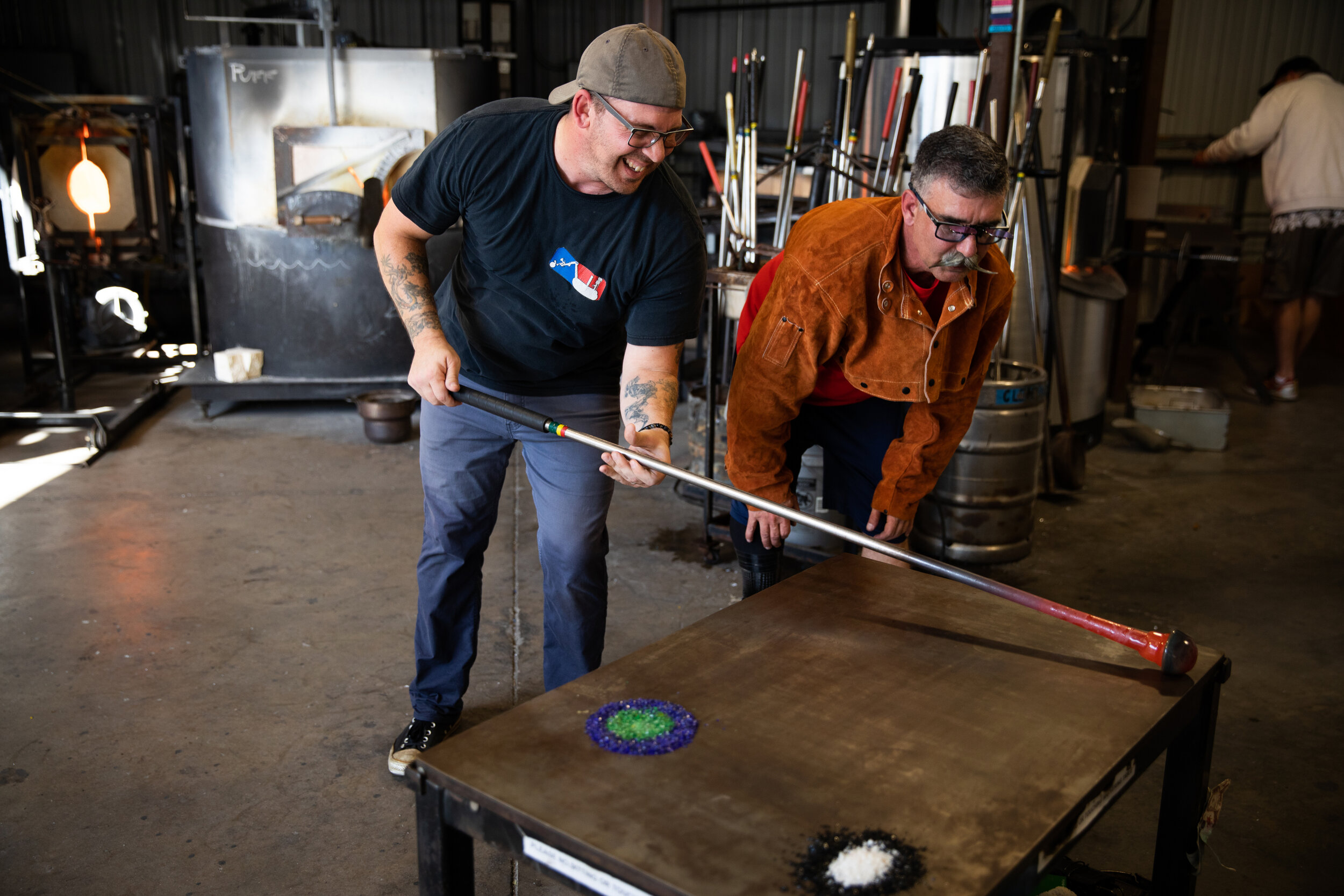Chris Stowe was a bomb tech in Djibouti, Kosovo, Macedonia, Iraq, and Afghanistan for the U.S. Marine Corps. Years of explosions and death left him living behind a mask of numbness, apathy, and anger. “Art,” he says, “saved my life.” In Florida, he’s working to bring art therapy to more vets like him.
Story by Russell Worth Parker | Photographs by Charlotte Kesl
Rayburn House Office Building, Washington, D.C., February 26, 2019
Retired Marine Master Gunnery Sgt. Chris Stowe stands just far enough away from the people with whom he is waiting to appear distinct from the group. He focuses on the problem before him, another in a long line of challenges he’s been called to solve. Though Stowe is of average height, his broad shoulders, sturdy jaw, and dark eyes that sparkle with intensity when he speaks give him an outsize presence. There’s a tension in the air. The people gathered know Chris’ success is their success and will have implications for their collective future. They seem to nervously vacillate between leaving him to the moment or offering him encouragement. Someone asks, “How do you feel?” He smiles wryly.
“Fine, till you asked.” Then, he closes his eyes and, for just a moment, tries not to think about the importance of the task he’s about to undertake for people who won’t ever know he undertook it. “But it’s not my first time here.”
Chris Stowe spent 24 years as a United States Marine, 19 of them as an Explosives Ordnance Disposal (EOD) Technician — a “bomb tech” as they call themselves. Chris has been called to solve potentially explosive problems in Djibouti, Kosovo, Macedonia, Iraq, and Afghanistan. Working each day with the highest of stakes is lonely, and it imbues people who do it repeatedly with a certain calm. It must be akin to what Neil Armstrong felt stepping out onto the moon’s airless plain, gazing at a vista no one else had ever seen, and knowing in that moment he alone understood the vastness of the task before him.
Bomb techs don’t comprise as exclusive a club as lunar explorers, but to be one in a war zone is a voluntary pursuit that means the daily acceptance of an intimate role in the potential of one’s own end. Chris’ mind and body are marked by that grim reality.
Chris Stowe standing in a bomb crater in Iraq (photographer unknown). The blasts left Chris breathless, as if he had taken a hard shot to the solar plexus, followed by headaches he “never thought much about.”
But today is different. Chris is still fighting, but not in Iraq or Afghanistan — places where every trash pile, irrigation ditch, or street curb might conceal a lethal menace. Today, Chris stands in the marble hallway outside Room 2207 of the Rayburn House Office Building in Washington, D.C. No explosive device waits on the other side of the expanse. Instead, five members of the U.S. Congress wait for Chris to speak about the importance of funding $167.5 million dollars to the National Endowment for the Arts for, among other things, art therapy programs for veterans. For Chris, the stakes are much higher than the dollars. He knows all too personally the eventual stakes may be life or death for another veteran. In some ways, Chris’ life has been one long walk toward a potentially explosive ending.
It’s not his first time here.
Chris Stowe grew up in Warren, Ohio, a Rust Belt testament to the death of industry, filled with resounding echoes of broken families, crime, and substance abuse. Chris’ father abandoned him there, along with his sister and mother, when Chris was 2 years old. They moved in with his maternal grandparents, a couple who built their lives around 30 years in a steel mill. In a tragic bit of unintended poetry, Chris’s relationship with his father mirrors that of the nation with his hometown. His father called when the notion struck him, promising a visit and some desperately wanted father-son time, then failed to show, leaving a boy sitting on a porch, staring into nothing, wondering why he kept believing the same old lies.
That his father ultimately traded life with a home and family for a cheap apartment over a bar and death guzzled from plastic bottles of bulk-rate vodka makes it no surprise young Chris sought an authority figure. In 1993, a Marine Corps recruiter in dress blues offered him just that. Chris enlisted for whatever job the Corps needed him to do. Thus, a kid with a latent artistic streak became a “Graphics Specialist,” tasked with making pamphlets, informational displays, and training aids.
For Chris, the Marine Corps awoke a latent need for a challenge that producing posters and training aids could never fulfill. After his first enlistment, he considered looking outside the Corps, but in 1998 an Explosive Ordnance Disposal demonstration featuring Marine bomb techs in bulky, padded, blast suits riveted him with their tales of potentially lethal puzzles.
Chris says he was intrigued by the requirement to “out think a problem set of that magnitude.” He laughingly acknowledges that the idea of earning a “Crab,” the nickname of the shiny qualification badge bomb techs wear as a testament to their bravery, grabbed him in the guts. Chris Stowe became a man who defused bombs, a procedure bomb techs call “render safe,” because he viscerally felt the importance of “serving those who serve.”
For an untested young Marine, EOD also seemed like “the best way for me to get into the fight if we ever went to war.” In the wake of the 1990’s peace dividend, Chris’ EOD badge, with its wreath surrounding a bomb backed by lightning bolts, sufficed as evidence of his bravery. Then came that perfect azure morning in September 2001, a sky suddenly broken and black, followed in relatively short succession by the invasion of Iraq in March 2003, and the rules of Chris’ world changed. A badge no longer sufficed. The world of the bomb techs, as much or more than the rest of the military, became a genuine “put up or shut up” culture.
Stowe in Iraq working on Explosive Ordinance Disposal (photographer and other men pictured unknown). Bomb techs use the term “render safe” to refer to the process of defusing a bomb.
By 2006, Chris was on his third Iraq deployment in three years. In his memory, those days are one unrelentingly brutal tableau punctuated by acts of particular savagery. Among countless smaller bomb strikes, some stand out: a suicide car bomb exploding between his truck and the vehicle in front of him; being at the scene of a bombing that killed three Americans, having just moved to the far side of an armored vehicle when a second bomb exploded, knocking him flat in the street; a sniper’s bullet humming past his ear and hammering the truck door where his head had been a heartbeat before, fragments from the shattered round tearing through his hand and face. Even when Chris found the bombs first, the exigency of combat often demanded he be in close proximity to the explosives he used to destroy them. The blasts left Chris breathless, as if he had taken a hard shot to the solar plexus, followed by headaches he “never thought much about.”
Chris Stowe Dealing with an IED, or improvised explosive device, in Iraq (Photographer Unknown)
War does a moral violence that pierces the psyche as surely as hot steel tears through flesh. Chris remembers arriving in the aftermath of a bomb blast to find the final testimony of an acquaintance’s existence written across the side of a vehicle in viscous sprays of flesh and blood, like profane graffiti. He and his Marines checked the bodies of Iraqi people who had been executed by insurgents to ensure they did not conceal bombs. Then they delivered them to the local hospital, often into the hands of families who knew them only by the identification cards their executioners shoved into holes left in their heads by the heat and shock of cavitating bullets.
Iraq meant finding himself and another Marine squeezed together like teenage lovers, trying to disappear behind the steaming engine block of a freshly detonated car bomb as an insurgent’s machine gun rounds rent the pavement on either side of them. Writing for the Veteran’s Administration, Drs. Shira Maguen and Brett Litz describe moral injury as “a construct that describes extreme and unprecedented life experience including the harmful aftermath of exposure to such events,” further writing “[i]n the context of war, moral injuries may stem from direct participation in acts of combat, such as killing or harming others or indirect acts, such as witnessing death or dying, failing to prevent immoral acts of others, or giving or receiving orders that are perceived as gross moral violations.”
Chris’ moral injuries weighed more heavily upon him than any physical risk, and by 2007, he was mentally and physically exhausted. He developed a stutter. Sleep became ephemeral. Anger spiked. Desperate for some relief, Chris found himself contemplating turning in his Master EOD badge, the very symbol of his identity as a Marine bomb tech. He began a start-and-stop relationship with therapy. But when getting better got too hard, he relied on the medicine that always worked: deployment. Chris returned to the Middle East. Then Haiti in the horrific aftermath of the 2010 earthquakes. Then came Afghanistan.
War does a moral violence that pierces the psyche as surely as hot steel tears through flesh. Chris Stowe’s moral injuries weighed more heavily upon him than any physical risk. (Photo by Charlotte Kesl)
Given the small size and intense friendships of the bomb tech community, the seven-month “work-up” Chris spent preparing for Afghanistan at his home base in North Carolina felt as if he were already in the fight. As he prepared himself and his fellow techs to deploy, bombs in Afghanistan killed two Marines from their small unit who were already there. Seventeen other Marines from the unit were rendered single, double, or triple amputees. Chris felt the shockwaves of those distant explosions as surely as those he endured in Iraq. It was as if those Afghan flames and fragments tore across continents and oceans to find bloody purchase with Chris before he had even left North Carolina. In Retire the Colors, a compendium of writing by post-9/11 veterans, Chris wrote about unexpectedly meeting the wife of a friend and Marine in the wake of his recent death:
I hug her, and she holds on exactly how you would expect a widow to hold onto one of her deceased husband’s friends: Like she is trying to consume any piece of E.J. I have in me. My sour sweat mixes with her perfume and becomes suffocating to both of us. The smell reminding her of her husband’s cammies in the wash, and her smell reminding me that I too have a wife that could very well be in Kim’s shoes in a few short weeks. We both feel the moment bearing down on us like gravity just tripled.
Chris Stowe during a deployment in Djibouti. He wears the EOD technician badge on his chest (photographer unknown).
Perhaps it is ironic that Afghanistan is where Chris Stowe finally found his limits. Having risen in rank, his deployment there saw him supervising disparate teams of Marines spread throughout the historically restive Helmand Province from within the relatively safe confines of a large U.S. base. In Afghanistan, Chris did not actively contend with devices meant to kill and maim. Nor was he personally subjected to the inexorable violence he experienced in Iraq. Ironically, that secure isolation proved to be the main problem. Chris Stowe is someone who puts his hands to work for the betterment of others. Sitting safely behind the concrete walls of a base while his Marines dealt with threats all too familiar did not rest easily on Chris Stowe’s broad shoulders.
Seven years later, Chris easily pulls up photos on his phone of the two Marines killed and six wounded during his Afghanistan deployment. He calls them “my Animals.” That may sound brutal, but any Marine would understand the respect and admiration that term carries for Chris. These Marines are immediately present when he speaks of them, even for a listener who never knew them. Every wounded or dead Marine meant a helicopter ride to that team’s location to inventory and pack the Marine’s equipment. Then it was up to Chris to console the team while simultaneously inspiring them back into action. It’s a process that either hardens you or breaks you. Places like Helmand Province’s Sangin and Musa Qaleh gave him far too many opportunities for both. Chris took each casualty personally, as an individual failure, but each added to the collective weight he carried. He shouldered the weight, because that’s what Marines are expected to do, but it grinds down even the strongest over time. If one is determined to carry it alone, the weight only gets heavier.
Bullet wounds like Chris’ are easy to explain in a warrior culture. The scar and story will get you a beer in any airport bar. Like all Marines who wear it, Chris is venerated for the Purple Heart Ribbon, indicating combat wounds, which he wears under the Master Explosives Ordnance Disposal Technician Badge on his chest. But like the majority of those suffered by service members since 2001, most of Chris’ injuries are invisible. The chief weapons of insurgents in the post-9/11 wars are explosive devices that can cause significant neurological injuries, irrespective of heat and fragmentation impacts. Arguably, the signature injuries of Chris Stowe’s wars are traumatic brain injury (TBI) and post-traumatic stress (PTS).
TBI is caused by sudden trauma to the brain, like that brought on by an explosive shock wave. A non-comprehensive list of symptoms may include immediate or prolonged loss of consciousness, disorientation, headache, nausea, vomiting, sleep issues (too much or too little), dizziness, and loss of balance. Still, many TBI effects are visible, clearly wrought by the direct actions of an armed enemy, and therefore more easily accepted in military culture.
Less immediately comprehensible are the psychological wounds war imposes. In modern parlance, it is called post-traumatic stress. PTS is physiologically and psychologically normal. But despite laudable efforts by some very senior military leaders to speak out about their own struggles, the acceptability of normal responses to abnormal conditions has been slow to filter down to the boots on the ground.
By the time Chris returned from Afghanistan, he was on five psychotropic medications, leaving him, he says, simultaneously “numb, apathetic, and furious.” Seeking relief from the side effects, he cycled off the medicine, only to be simply furious. Further symptoms read like a case study of combat trauma: depression, insomnia, anxiety. Panic attacks consumed him, caused by his conviction that he was to blame for the deaths and injuries of his Marines. As before, Chris made an attempt at therapy, but he ultimately lays the credit for the genesis of his recovery at the feet of his wife, Brandy Stowe, the relentlessly positive dynamo who mothered their two children throughout all those years of deployment.
“She’s why I’m here,” he says. “She said, ‘If you don’t get help, we’re gone.’”
Chris Stowe credits his wife Brandy (not pictured) for starting him on the path to recovery that ultimately saved his life and their family. “She’s why I’m here,” he says. “She said, ‘If you don’t get help, we’re gone.’” (Photo by Charlotte Kesl)
Brandy’s ultimatum led Chris to the National Intrepid Center of Excellence (NICoE) Program at Walter Reed Army Medical Center in Bethesda, Maryland. NICoE is a Congressionally directed, Department of Defense-initiated center for research and treatment of Traumatic Brain Injury and Post-Traumatic Stress. Opened in October 2010, thanks to a $65 million initial endowment from the private nonprofit, the Intrepid Fallen Heroes Fund, NICoE provides a four-week program for patients and families coping with brain injuries and psychological health issues.
Care providers worked with Chris and Brandy to begin a comprehensive healing plan for Chris’ mind, body, and spirit, a way of living they could take out of a clinical setting and make a part of the family’s everyday life. As part of that, Chris underwent an exercise designed to get him to apportion responsibility for the deaths and injuries of his Marines. True to form, he claimed 100 percent. By the end, the therapist had gotten him to reduce his role to 22 percent. Carrying a quarter of the weight of dead and grievously injured brothers is still a heavy load, but as clarity offered itself, Chris can now at least say, “It’s impossible for me to be 100 percent responsible … but it still doesn’t play well in my heart.”
Twelve years after trading a graphic artist’s pen for a bomb tech’s tool kit and life on a knife’s edge, Master Gunnery Sgt. Chris Stowe found himself sitting at a table at NICoE. Surrounded by six fellow service members, he was in an introductory art therapy class.
Before each of them sat a blank paper mache form that would become a mask intended to symbolize each member. Program Coordinator Melissa Walker provided boxes of clay, plastic, wire, beads, paint, feathers. Even now, there is a palpable electricity in the air when Chris describes the moment he saw the blank mask and materials, “My brain shut off — like, I blacked out — and before I knew what I was doing, my hands just started working. I was disconnected from the moment and plugged into the darkest spots in my brain.”
Chris has never replicated the sensations he experienced while making the mask and does not want to. He doesn’t ever want to go back to the places the mask illuminated. In fact, when it was complete, he placed the mask in a box and left it at NICoE, where it remains to this day. He compares it to Poe’s “The Tell-Tale Heart”: “It’s not a feeling of guilt or shame though … it’s fear. I am scared of it because it represents the potential of who I could be in the absence of reason and light — a monster … a demon.” Nonetheless, Chris credits the mask as the catalyst for much that has come after. Making that mask, he says, was “the key to it all.”
Though he left it behind at NICoE, Chris Stowe can pull up a picture of the mask on his phone almost immediately, just like the pictures of his fallen Marines. Like those dead and wounded men, the mask is a fundamental part of him; something from which he will never be completely separate. Chris Stowe’s finished mask appears as a face with the left half stripped of skin — raw meat bloody and exposed. Bees crowd the eyes and mouth and emerge from the ragged edge of its torn flesh. The bright yellow and black insects represent a manifestation of the symptoms of PTS, which Chris likens to having a bee’s nest in his chest. Sometimes the beekeeper inundates the bees with smoke, holding them to a dull buzz. Sometimes it’s as if someone struck the nest with a stick, driving the bees into a stinging frenzy.
On the half of the face still covered by skin, a tear emerges from a corner of the remaining eye, its iris the same color as Chris’s eyes. Two holes mar the smooth skin in the same places bullet fragments tore through his face. In Chris’ fugue state, the wire Melissa provided amongst the mask materials appeared to him as command detonation wire for an improvised explosive device. Now that wire emerges from those paper mache avulsions, with their hanging flaps of skin painted to represent his own wounds. It is as if he could no longer contain the memories of the devices so central to his undoing and they now erupted from him.
Chris describes completing the mask almost before his peers began their own. Emerging from the oblivion in which he had been submerged, even the combat experienced troops around him looked at him “as if they were looking at a bad car wreck.” As for himself, Chris had an epiphany. Though he felt simultaneously worse and better, the mask making process revealed a truth from which he could no longer hide, “I knew I had a subconscious to deal with. I could manipulate therapists to get back out on deployment, but I couldn’t lie about the results in front of me.”
For the remainder of his time at NICoE and Walter Reed, Chris was fully engaged in the Creative Forces Arts Program. Creative Forces is a partnership between the National Endowment for the Arts, the departments of Defense and Veterans Affairs, and state and local arts agencies, that serves Walter Reed and 11 satellite centers across the nation. As part of the program, Chris painted. He sketched. He wrote. A writing prompt he received from the Veteran’s Writing Project, a partner within Creative Forces, turned into a haunting piece on moral injury published in their literary magazine, “O-Dark-Thirty”:
After once again confirming that the dead body is, in fact, still dead, we finally blow up the IED and head back to base. I start inventorying the emplacer’s pocket trash. My hair feels like it is full of electricity and my mouth has the taste of a battery as I come down from my near zombie encounter. I look at his ID card and my stomach drops. 15 years old. Fifteen. The guy – no, the boy – I have just killed is 15 years old and he lies in an alley riddled with bullets while my own 13-year-old son is just starting his day 4,000 miles away. My world tilts out of view. I wonder how the boy’s father is feeling. I see my own son lying there instead of the Iraqi: two holes in his head and one in his neck. I see my son at home starting his day. He is waking up and wiping the sleep out of his eyes. I also see the father of the dead Iraqi boy wiping flies away from his son’s eyes as he is found in the morning.
In the final years of his service, as he began to more effectively contend with his own issues, Chris sought to support others in their own journeys home. Perhaps most importantly for the man he has become, Chris recognized “there is a deep relationship between art and healing.” Master Gunnery Sergeant Chris Stowe would be silent and bear the weight alone no more.
Chris recognized “there is a deep relationship between art and healing.” Photos by Charlotte Kesl
In 2013, Chris sought and received a competitive assignment to a Congressional Fellowship where he authored legislation meant to synchronize the systems by which wounded and disabled veteran’s disability claims are tracked between the Department of Defense and the Veterans Administration. Chris sought to mandate a common system to track individual claims, tell how long a veteran’s file has been at a specific point in the process, and provide an automatic notification to both departments’ headquarters if it lingers at a particular point in the process for too long.
With veteran suicides averaging 17 per day, Chris’ idea to streamline accountability between the two monoliths and improve the responsiveness of care seems obvious. The House adopted the legislation in their version of the National Defense Authorization Act and the Veteran’s Affairs Committee named it as their lead legislative priority. Then the Senate dropped it. The failure to pass the legislation was a sign to Chris, a man who works best elbow deep in the guts of a problem, that he would have to do what he could on his own.
Chris sought a follow-on assignment as the liaison for wounded special operations personnel at Walter Reed National Military Medical Center, accounting and advocating for men and women like himself. During that assignment, Chris found himself vetting an internship he created for wounded service members. The internship’s schedule occupied Chris’ mornings and evenings but left mid-day open to contemplate his fast-approaching civilian life.
A chance visit to a glass-blowing studio in St. Petersburg, Florida led Chris to apply for an art therapy grant. For 13 weeks, three days a week, Chris fit a glass-blowing course around his internship duties. Blowing glass, he says, gives him “instant access to being centered and in the moment. You cannot ruminate or worry about what-ifs when you have molten glass at 2,100 degrees Fahrenheit a couple of feet from your skin. And if you are not purely in the moment as you attend to your piece, it will end up ruined in the blink of an eye.”
Not satisfied to reserve this healing benefit for himself, Chris roughed out what an art therapy course for service members and veterans might look like before he retired in 2016.
Through Operation: Art of Valor Chris Stowe works with other military veterans in glassblowing and metal work. Stowe says blowing glass gives him “instant access to being centered and in the moment. You cannot ruminate or worry about what-ifs when you have molten glass at 2,100 degrees Fahrenheit a couple of feet from your skin. And if you are not purely in the moment as you attend to your piece, it will end up ruined in the blink of an eye.” Photos by Charlotte Kesl
Today, art and veteran’s issues are still of critical importance to Chris Stowe. In 2017, serving on the board of advisors for a Creative Forces art therapy summit in Tampa, Florida, Chris met Michael Killoren. Michael had just left the National Endowment for the Arts in Washington, D.C., to assume the executive directorship of the Morean Arts Center, a 102-year-old arts education institution in St. Petersburg, Florida. Having learned from his own time on Capitol Hill, Chris engaged Michael with what had become a well-honed “D.C.-style elevator pitch” about an underserved population.
Immediately seeing the value of the idea, Killoren lent critical assistance in structuring the plan. Perhaps even more importantly, Matthew Piepenbrok, a longtime glass artist and manager of the Morean Arts Center glass blowing studio, was immediately supportive. Matt brought critical expertise and experience in the practicalities of the art and understanding how best to structure a program for success. Matt and Chris joined forces to co-found Operation: Art of Valor (OAV), with a mission to “serve the military and veteran population through structured, hands-on learning that focuses on improving cognition, social interaction, physical dexterity, teamwork, and confidence.”
The Morean Arts Center remains overwhelmingly supportive of OAV. Under the OAV banner, Matt and Chris lead free glass-blowing classes for service members and veterans every Sunday morning from 8 a.m. to noon. Matt runs day to day operations out of a budget built on donations to the Morean Arts Center while Chris works with him to expand OAV’s reach and capability.
Dealing with unstable explosives taught Chris how to identify problems and systematically plan solutions. Sunday classes at the Morean Arts Center are a wonderful start. But many of the veterans Chris wants to reach can’t get there due to homelessness or remoteness. Many can’t travel due to disability or cost. To overcome such pernicious challenges, Chris is raising funds to buy a mobile shop made by Mobile Glassblowing Studios, a company founded by two sculptors, educators, and glass artists in Americus, Georgia. Their mobile studio, designed to make glass blowing accessible to anyone, will cost $21,000. Chris sees a mobile studio as the springboard for Operation: Art of Valor’s long-term objective, a “military/veteran creative hive to rent space to artists in residence, with woodworking, metal sculpting/fabricating, glassblowing, and other featured visual arts as the focus.”
“I can state unequivocally that art therapy has helped me to be a better human, husband, father, and friend,” Chris Stowe told the Representatives, while testifying before Congress on behalf of The American Art Therapy Association. “I can also state unequivocally that art therapy has helped save my life.” Photo by Charlotte Kesl
Back in the Rayburn Building
Perhaps it is surprising that a man who sacrificed so much of himself to fire and force and shock should now find salvation in an art that subjects him to many of the same forces. But like a forest that flourishes after a burn, Chris Stowe found new life in mastering the forces that took so much from him, his family, and so many of his peers. That’s why he gladly came to Washington at the request of the American Art Therapy Association. It’s why he found himself across the table from the Congressional Subcommittee on Interior, Environment, and Related Agencies.
Testimony begins with the legislators themselves. They assure all in attendance of their appreciation and deep interest in the topic at hand. They graciously acknowledge the witnesses and audience members alike, thanking both for their interest in this important issue. Noting Chris as the first to testify, they make sure to express their connections to, and appreciation for, America’s military. Chris’ fellow witnesses, an impressive and dedicated lot representing the environment, native communities, and cultural organizations did the same before they entered the room.
The weight once again rests on Chris’ shoulders. The legislators listen as Chris speaks, clearly and directly, in the fashion of the Marine that is still so much of him, even as he’s become so much more.
“I can state unequivocally that art therapy has helped me to be a better human, husband, father, and friend,” he tells the Representatives. “I can also state unequivocally that art therapy has helped save my life.”
It’s not an easy thing to lay oneself bare in a room full of legislators and reporters, but Chris Stowe knows how to center himself, approach a challenge, and perform under pressure.
After all, it’s not his first time here.
Postscript
The National Endowment for the Arts budget line has been targeted for elimination every year since 2017. On March 11, 2019, 13 days after Chris’ testimony, the proposed budget for 2020 sought to do the same. However, in an increasingly rare show of bipartisanship, legislators ultimately authorized a $7.5 million increase for the NEA, coming in at $162 million for 2020.
Perhaps it is not coincidental that a joint U.S. Bureau of Economic Analysis and NEA report found the arts contributed $763.6 billion to the U.S. economy in 2015, a sum greater than that contributed by warehousing, transportation, or even agriculture. Maybe Chris’ words and actions actually held sway that day in February. Maybe the members of Congress who heard him speak grasped the truth, that art saved Master Gunnery Sgt. Chris Stowe’s life and can yet save the lives of his fellow veterans, a critical obligation in light of the evergreen quality of America’s post-9/11 wars.
Note: If you are a Veteran and you need help, please call the Veterans Crisis Line at 1-800-273-8255 (Press 1)
If you are thinking about suicide, please call the National Suicide Prevention Lifeline at 800-273-TALK (8255).


